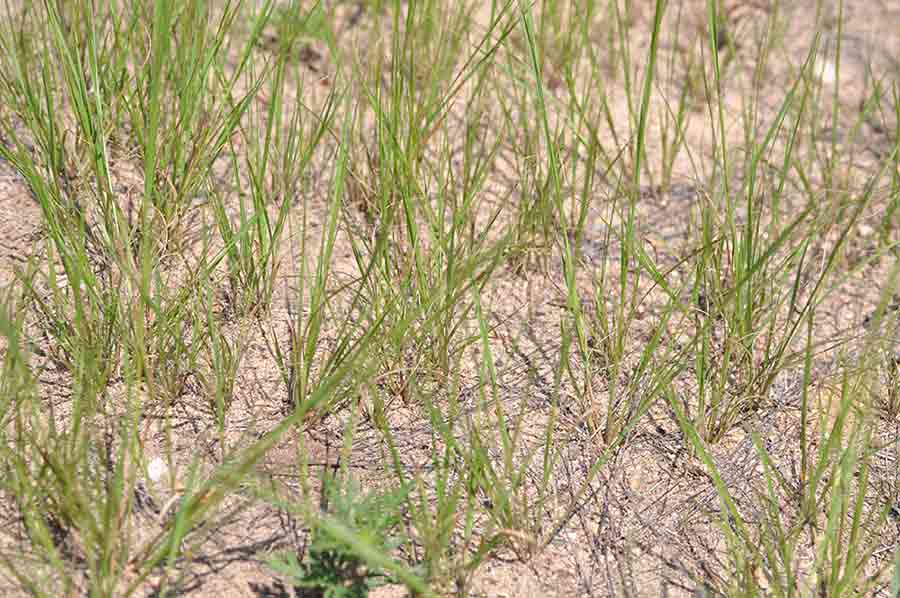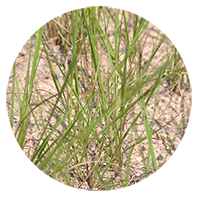Forked Three-awned Grass

Introduction
This chapter provides a review of progress toward protection and recovery of Forked Three-awned Grass in Ontario from 2007 to 2015.
Species information
Forked Three-awned Grass (Aristida basiramea) is an annual plant that grows 30 to 60 centimetres in height. Forked Three-awned Grass has extremely narrow leaves that often curl inward at the edges. These leaves are approximately one millimetre wide and five to 15 centimetres tall. The species mainly branches out from the base. Forked Three-awned Grass also has bristle-like structures, called awns, attached to specialized leaves that enclose the flower.
In Ontario, Forked Three-awned Grass exists in Simcoe County and on islands in Georgian Bay. Forked Three-awned Grass grows on open, bare ground or in sparsely vegetated areas. The species often occurs in bare spots between tufts of other grass species.
Forked Three-awned Grass faces several threats to its survival and recovery, the most significant being succession, development and invasive species. Each of these can cause suitable habitat to become unsuitable for the species. Through succession, vegetation fills in open ground making areas unsuitable for Forked Three-awned Grass. Invasive species may affect Forked Three-awned Grass in the same way by filling in empty spaces that could otherwise provide habitat for the species.
The survival and recovery of Forked Three-awned Grass are influenced by other factors as well. The most significant limiting factor for the species is availability of suitable habitat. Forked Three-awned Grass depends on the availability of open, bare ground or sparsely vegetated areas. The species also matures very late in the growing season. Because Forked Three-awned Grass matures in late August or September and sets fruit in September or October, it is naturally limited by the arrival of the end of the growing season in a particular year and individuals plants may be prevented for seed setting if there is an advancing cold winter in the fall.
Forked Three-awned Grass is listed as endangered at both the provincial (Species at Risk in Ontario List) and the federal (Schedule 1 under the Species at Risk Act) levels. Globally, it is considered to be secure.
Provincial status
Prior to the Endangered Species Act, 2007 (ESA or "the Act") the Committee on the Status of Species at Risk in Ontario (COSSARO) assessed Forked Three-awned Grass as endangered. It was listed on the Species at Risk in Ontario List as endangered in 2004, but was not regulated under the previous Endangered Species Act. The species retained its endangered status when the ESA came into force in 2008. In future assessments, COSSARO may consider information gained through protection and recovery actions regarding the species' threats and trends in population and distribution.
Species and habitat protection
Protecting Forked Three-awned Grass and its habitat are key components in the implementation of the ESA, and continue to be government-led actions, as identified in the species' government response statement. As an endangered species, Forked Three-awned Grass has been protected from being killed, harmed, harassed, captured or taken under the ESA since it came into force in 2008. In addition, the species' habitat has been protected from being damaged or destroyed since June 30, 2013, based on the general habitat definition in the ESA. Transition to the ESA provided increased protection for the species and its habitat over what may have been provided prior to 2008 through other legislation or policies.
The ESA does not require a habitat regulation to be developed for transition species
Any person who negatively impacts Forked Three-awned Grass or its habitat without prior authorization may be prosecuted under the ESA.
Forked Three-awned Grass has been protected from being killed, harmed, harassed, captured or taken since 2008.
In addition, the habitat of Forked Three-awned Grass has been protected from being damaged or destroyed since 2013, based on the general habitat definition in the ESA.
Recovery strategy
A recovery strategy for Forked Three-awned Grass was completed on February 18, 2011, which was in advance of the date required by the ESA. Recovery strategies are advice to government and represent the best available scientific knowledge. The strategy identified Forked Three-awned Grass habitat needs and the threats that it faces, while recommending objectives and approaches for protecting and recovering the species. The recovery strategy also included recommendations on the areas of habitat to be considered in the development of a habitat regulation.
Government response statement
The Ministry of Natural Resources and Forestry ("the Ministry") published the government response statement (GRS) for Forked Three-awned Grass on November 18, 2011, which was within the timeframe required by the ESA. The GRS is government policy that contains the Government of Ontario’s goal for the recovery of Forked Three-awned Grass.
To help achieve this goal, the government leads and supports recovery actions identified in the GRS. Common actions for the government to lead as it works toward achieving a species' recovery goal are provided in section 2.5 of the Species at Risk Program Status (2008-2015). One specific action for the government to lead to help protect and recover Forked Three-awned Grass is:
Recovery Goal
The government’s goal for the recovery of the Forked Three-awned Grass is to maintain self-sustaining populations at all currently occupied sites within the species' native distribution in Ontario.
- Ensure appropriate timing windows for undertaking activities (e.g., mowing, grading of roadside shoulders) in and around Forked Three-awned Grass habitat are considered in the application of the ESA.
The GRS for Forked Three-awned Grass also lists seven actions the Ministry supports others to undertake for the species. These government-supported actions fall under the objectives identified in the GRS, which are:
- Reduce identified threats and increase available habitat for Forked Three-awned Grass;
- Determine the distribution and abundance of Forked Three-awned Grass and improve knowledge of the species' biology and habitat requirements; and
- Increase awareness of Forked Three-awned Grass and promote its protection and recovery.
Supporting our partners
Supporting partners through the Species at Risk Stewardship Fund, as well as through permits and their associated conditions, is an important government-led action. To-date, no authorizations or regulatory provisions have been issued or registered for the species. Ministry staff will continue to provide advice on appropriate timing windows in any future authorizations for carrying out activities in Forked Three-awned Grass habitat.
Through the Species at Risk Stewardship Fund, the Ministry has supported a total of four projects ($145,515) designed to contribute to the protection and recovery of Forked Three-awned Grass. All of these projects targeted multiple species at risk, including Forked Three-awned Grass. As well, partners were successful in securing additional funding ($54,886) from other sources. This amount includes additional funding and in-kind support in the form of the time and expertise provided by volunteers.
Ontario’s Invasive Species Act
The GRS for Forked Three-awned Grass indicates that invasive species pose a threat to the survival and recovery of the species in Ontario. The provincial Invasive Species Act, 2015, came into force on November 3, 2016 and provides an enabling framework to support the prevention, detection and control of invasive species in Ontario. This framework may support actions to reduce the threats of invasive species on native and at-risk species, including Forked Three-awned Grass.
Stewardship partners reported that provincial funding helped them to secure in-kind support by involving 98 individuals who volunteered 321 hours of their time toward protection and recovery activities for multiple species at risk, including Forked Three-awned Grass, which has an estimated value of $8,030. Stewardship partners reported providing outreach on multiple species at risk to 2,872 individuals.
The remainder of this section highlights a project that was supported through the Species at Risk Stewardship Fund and its corresponding government-supported recovery actions.
Education and outreach material was developed by Beausoleil First Nation for multiple species at risk, including Forked Three-awned Grass. This material was used at a variety of public events such as a biology career day and within schools on Christian Island. Interviews with Indigenous community members were also conducted to collect Traditional Ecological Knowledge (TEK) on species at risk. Furthermore, this partner discussed conservation agreements with landowners who had Forked Three-awned Grass habitat on their property on Christian Island. This action contributes to supporting the GRS action to develop and provide information to private landowners, Indigenous communities and others to increase awareness of the species' distribution and threats, and to foster good stewardship.
Beausoleil First Nation also completed surveys for Forked Three-awned Grass on three properties with suitable habitat. The species was identified at one location, as well as another location not included in the initial scoping of suitable habitat. These locations were added to species at risk mapping and expanded the mapped boundaries of the population of Forked Three-awned Grass on Christian Island. Consultations with landowners for these newly-identified locations were performed to facilitate protection of the species. This action supports progress toward surveying areas for potential populations of Forked Three-awned Grass.
Development and implementation of best management practices
Best management practices have been developed and implemented on Christian Island by Beausoleil First Nation. Habitat conditions for Forked Three-awned Grass have been improved through the removal of invasive species and conducting prescribed burns between 2013 and 2015. Funding and support for this work was provided by Environment and Climate Change Canada through the Aboriginal Fund for Species at Risk (AFSAR) and supports progress toward the high priority government-supported action to develop and promote best management practices for landowners, land managers and others to reduce potential threats to Forked Three-awned Grass, such as invasive plant species.
Species at Risk Stewardship Fund
-
 $0
$0for Forked Three-awned Grass exclusively
-
 $145,515
$145,515for multi-species projects that included Forked Three-awned Grass
-
 $54,886
$54,886in additional funding and in-kind support
-
 4
4projects included the Forked Three-awned Grass
-
 98
98volunteers
-
 321
321volunteer hours
-
 2,872
2,872people received outreach
Occurrences of Forked Three-awned Grass in Ontario
Natural Heritage Information Centre (NHIC)
Forked Three-awned Grass is known to occur in 13 populations
Since 2008, when Forked Three-awned Grass became protected under the ESA, the Ministry has received approximately 99 records of the species. These records are based on observations between 2001 and 2010 and come from a variety of sources. No new populations of Forked Three-awned Grass have been found; however, the species has been discovered at new locations within several of the populations expanding our knowledge of the species' current distribution in Ontario. It is possible that there are observations of Forked Three-awned Grass that have not been submitted to the Ministry. Encouraging the submission of observations of Forked Three-awned Grass to the Ministry is included in the GRS as a government-led action.
Everyone is encouraged, or may be required by an authorization or approval, to submit observations of Forked Three-awned Grass, as well as every other species at risk, to the Ministry’s Natural Heritage Information Centre for incorporation into the provincial record of observations.
Surveying and Monitoring for Forked Three-awned Grass
Surveys were conducted by partners and federal agencies in 2009 or 2010 to update abundance information for many populations of Forked-Three awned Grass. Additionally, monitoring for Forked Three-awned Grass has been established at Beausoleil Island and Christian Island. At Beausoleil Island, Parks Canada monitors the area of occupancy, density, distribution and habitat quality of Forked Three-awned Grass. On Christian Island, three permanent transects were established to determine population size, observe fluctuations and the impact of any active threats (Environment Canada 2014). These actions contribute to progress toward the high priority government-supported action to implement a monitoring program at current Forked Three-awned Grass locations to track changes in populations and impacts of threats.
99 Observations of this species were submitted to the NHIC since 2008.
Summary of progress toward meeting the recovery goal
Summary of progress
Progress has been made toward all government-led actions and several of the government-supported actions outlined in the GRS for Forked Three-awned Grass. The Government of Ontario has directly undertaken actions to:
- Encourage submission of Forked Three-awned Grass data to the Natural Heritage Information Centre;
- Protect the species through the ESA and its habitat through habitat provisions;
- Continue to ensure appropriate timing windows for undertaking activities in and around Forked Three-awned Grass habitat are considered;
- Support partners to undertake activities to protect and recover the species;
- Establish and communicate annual priority actions for support;
- Educate other agencies and planning authorities on the requirement to consider the protection of the species and its habitat; and
- Undertake communications and outreach to increase public awareness of species at risk in Ontario.
Government-supported actions are organized under over-arching recovery objectives. Progress has been made toward all of the government-supported recovery objectives and several of the associated actions that are identified in the GRS for Forked Three-awned Grass.
Under the objective to reduce identified threats and increase available habitat for Forked Three-awned Grass, progress has been made toward the high priority action:
- Develop and promote best management practices for municipalities, landowners, land managers and others to reduce potential threats to Forked Three-awned Grass, such as invasive plant species, road work, airport maintenance, garbage dumping, all-terrain vehicle use and mowing (Action No.1; High Priority).
Progress for this action has been completed by Beausoleil First Nation and federal agencies at two populations. Through funding provided by Environment and Climate Change Canada through the Aboriginal Fund for Species at Risk (AFSAR), Beausoleil First Nation have improved habitat conditions through the removal of invasive species and completion of prescribed burns.
Under the objective to determine the distribution and abundance of Forked Three-awned Grass and improve knowledge of the species' biology and habitat requirements, progress has been made toward the high priority action and initial progress has been made toward another action:
- Implement a monitoring program at current Forked Three-awned Grass locations to track changes in populations and impacts of threats (Action No. 3; High Priority); and
- Analyze mapped relict shoreline areas and survey these areas for other potential populations of Forked Three-awned Grass (Action No. 6).
Progress for the high priority action has been completed by partners and federal agencies by monitoring populations on Beausoleil Island and Christian Island. A project undertaken through the Species at Risk Stewardship Fund for Ontario has supported progress toward the other action by completing surveys for potential populations of Forked Three-awned Grass.
Under the objective to increase awareness of Forked Three-awned Grass and promote its protection and recovery, progress has been made toward the one action under this objective:
- Develop and provide information to municipalities, utility companies, private landowners, Aboriginal communities and others to increase awareness of the species' distribution and threats, and to foster good stewardship (Action No. 7).
This action has been implemented through various projects supported by the Ontario Species at Risk Stewardship Fund. Projects developed species at risk information brochures, provided information on species at risk on partner’s websites and conducted workshops for target organizations, such as industry.
The recovery goal for Forked Three-awned Grass is to maintain self-sustaining populations at all currently occupied sites within the species' native distribution in Ontario. Effort made toward the government-led and government-supported GRS actions has helped to make progress toward this goal. In addition, the provincial record of observations indicates that Forked Three-awned Grass is exhibiting trends that are consistent with the GRS recovery goal to maintain self-sustaining populations at all currently-occupied sites. Although, it is unknown what population size may be required to maintain a self-sustaining population of Forked Three-awned Grass, surveys have confirmed ongoing occupancy at nine of the provincial populations since 2008. The estimated viability of these populations range from excellent to fair or poor indicating that some populations are in excellent condition while a few are at risk due to possible habitat decline. Despite a lack of recently reported observations at the four remaining populations, these populations are still presumed to exist.
Recommendations
As stated in the GRS, the review of progress toward protecting and recovering Forked Three-awned Grass can be used to help identify whether adjustments are needed to achieve the protection and recovery of the species. Based on progress to-date, the overall direction provided in the GRS for Forked Three-awned Grass should continue to guide protection and recovery actions for the species, particularly actions identified as high priority in the GRS. Relative to actions that have received a high level of support, the following actions have received support to a lesser degree and may be considered in future decisions regarding the protections and recovery of Forked Three-awned Grass:
- While progress has been made toward implementing a monitoring program at a few Forked Three-awned Grass locations, implementing monitoring at locations where a program does not currently exist, as well as applying consistent monitoring methodology at all populations, will help to track changes in populations and the impacts of threats, which is identified as a high priority action in the GRS (Action No. 3; High Priority); and
- Actions for which progress has been limited should be supported in future implementation planning, such as supporting the securement of private land where Forked Three-awned Grass occurs through existing land securement and stewardship programs (Action No. 2); conducting research into key areas that may directly affect recovery, including seed viability and the role of the seed bank, natural ecological processes that maintain habitat, and methods that can be used in the absence of these natural processes (Action No. 4); and based on monitoring results and seed bank studies, modelling the dynamics of Ontario populations and undertake a population viability analysis for various Ontario sites (Action No. 5).
Moving forward, protecting and recovering Forked Three-awned Grass will continue to be a shared responsibility that will require the involvement of many individuals, organizations and communities. Working with Indigenous communities and organizations, as well as federal partners is critical to successful recovery. Financial support for the implementation of actions may be available through the Species at Risk Stewardship Fund, Species at Risk Research Fund for Ontario or the Species at Risk Farm Incentive Program. The Ministry can also advise if any authorizations under the ESA or other legislation may be required to undertake a project. By working together, progress can continue to be made toward protecting and recovering Forked Three-awned Grass in Ontario.
Summary of progress toward the protection and recovery of Forked Three-awned Grass (2007 to 2015)
Provincial status:
- Forked Three-awned Grass is classified as endangered under the Endangered Species Act, 2007 (ESA). Prior to its transition to the ESA, Forked Three-awned Grass was listed as endangered on the Species at Risk in Ontario List, but was not regulated under the previous Endangered Species Act. The species has been protected from being killed, harmed, harassed, captured or taken under the ESA since 2008, and its habitat has been protected from damage or destruction since 2013.
Species-specific documents and guidance published by the government:
- Recovery Strategy for Forked Three-awned Grass (2011)
- Forked Three-awned Grass: Ontario Government Response Statement (2011)
Supporting our partners:
- Through the Species at Risk Stewardship Fund, the Ministry of Natural Resources and Forestry (“the Ministry”) has enabled its stewardship partners to conduct a total of four projects ($145,515) that have supported the protection and recovery of multiple species at risk, including Forked Three-awned Grass.
- The Ministry’s support helped its stewardship partners to involve 98 individuals who volunteered 321 hours of their time toward protection and recovery activities for species at risk, including Forked Three-awned Grass. The estimated value of these voluntary contributions, as well as additional funding and in-kind support, is $54,886.
- Stewardship partners reported providing outreach on multiple species at risk, including Forked Three-awned Grass to 2,872 individuals.
Occurrences and distribution:
- Forked Three-awned Grass is known to occur in 13 populations within Simcoe County and islands in adjacent Georgian Bay. No new populations of the species have been discovered since 2008; however, continuing persistence has been recently confirmed at nine of the populations, and the species has been discovered at new locations within several populations.
Related information
- Categorizing and Protecting Habitat under the Endangered Species Act
- Natural Heritage Information Centre
- Ontario’s Endangered Species Act
- Ontario’s Endangered Species Act Regulation 242/08
- Ontario Recovery Strategy and Government Response Statement for Forked Three-awned Grass
- Policy Guidance on Harm and Harass under the Endangered Species Act
- Species at Risk in Ontario List
- Species at Risk Stewardship Fund
References
COSEWIC 2002. COSEWIC assessment and status report on the Forked Three-awned Grass (Aristida basiramea) in Canada. Committee on the Status of Endangered Wildlife in Canada. Ottawa. vi + 29 pp.
Environment Canada. 2014. Action Plan for the Forked Three-awned Grass (Aristida basiramea) in Ontario. Species at Risk Act Action Plan Series. Environment Canada, Ottawa. iv + 23 pp.
Footnotes
- footnote[1] Back to paragraph A "transition species" for the purpose of this report, is an endangered or threatened species listed under schedule 1, 3, or 4 of the ESA that has not changed in status since June 2008.